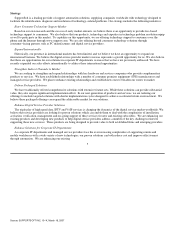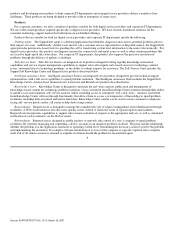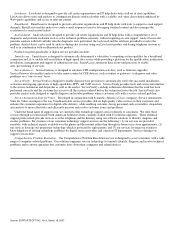Support.com 2006 Annual Report Download - page 19
Download and view the complete annual report
Please find page 19 of the 2006 Support.com annual report below. You can navigate through the pages in the report by either clicking on the pages listed below, or by using the keyword search tool below to find specific information within the annual report.
• the exercise of judgment by our management in making accounting decisions in accordance with our accounting policies; and
• general economic conditions and their effect on our operations.
In prior years, we licensed a significant portion of our software on a term basis in which revenue was recognized ratably over the
length of the agreement with the customer. In recent periods, however, we typically have licensed our software on a perpetual basis in
which we recognize the license revenue up front, assuming all criteria for revenue recognition have been met. As we have shifted to a
perpetual licensing model, we have become dependent on a few customer contracts with up−front license revenue for a substantial
portion of our revenue in any one quarter. In addition, a significant portion of our total revenue each quarter comes from a number of
orders received in the last month of a quarter. In previous quarters, we failed to close expected perpetual licenses with up−front
revenue resulting in a revenue shortfall. If in future quarters we fail to close orders expected to be completed by the end of a quarter,
particularly if these orders are for perpetual licenses with up−front revenue, our quarterly results would suffer and the market price of
our common stock would likely decline. We are seeking to introduce transaction structures that involve ratable revenue recognition,
but these types of transactions do not yet account for a material portion of our revenue.
Our inability to meet future financial performance targets that we announce or that are published by research analysts could
cause the market price of our common stock to decline.
From time to time, we provide guidance related to our future financial performance. In addition, financial analysts publish their
own expectations of our future financial performance. Because our quarterly revenue and our operating results fluctuate, future
financial performance is difficult to predict. In the past, we have failed to meet our guidance. Future downward adjustments of our
guidance or the failure to meet our guidance or the expectations of research analysts would cause the market price of our common
stock to decline.
Management’s ability to accurately predict performance is affected in large part by a significant portion of our total revenue being
dependent upon the closing of new large customer orders. In addition, our guidance is based in part upon the expectation of new
product sales and services offerings with which we have a limited history. In the event we fail to achieve projected revenue levels in
any quarter, we will be unable to reduce our expenses for that quarter in a corresponding fashion, and our results will not meet our
guidance or the expectations of securities analysts or investors, which would cause the market price of our common stock to decline.
The trading market for our common stock relies in part on the research and reports that industry or financial analysts publish about
us or our business. We do not control these analysts. If one or more of the analysts who currently cover us downgrade our stock, our
stock price would likely decline rapidly. Furthermore, if one or more of these analysts cease coverage of us, we could lose visibility in
the market, which in turn could cause our stock price to decline.
Because a small number of customers have historically accounted for and may in future periods account for substantial
portions of our revenue, our revenue could decline because of delays or losses of specific customer orders.
A small number of customers have historically accounted for, and may in future periods account for, substantial portions of our
revenue. For the quarter ended December 31, 2006, one customer accounted for 13% of our total revenue for the quarter. Transaction
structures that involve ratable revenue recognition and our consumer offerings, which typically involve payment on a per transaction
basis, could reduce our dependence on large transactions with a small number of customers. However, in the near term, we are likely
to continue to derive a significant portion of our revenue from large transactions with a limited number of customers. Therefore, our
revenue could decline because of the loss or delay of a single
15
Source: SUPPORTSOFT INC, 10−K, March 16, 2007
























